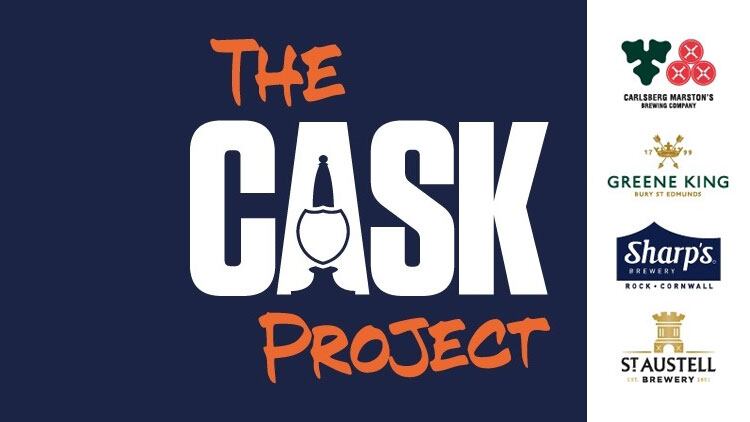The business operates pubs and a couple of pub-hotels, is strong on sustainability and always looking at how it can do more to keep itself front of mind for drinkers of all types of drinks – whether that be in the on and off-trade.
Cask beer has always been vital to the company that is based on the coastal town of Southwold, Suffolk, and production director Fergus Fitzgerald has plenty to say about what’s going on.
Fitzgerald explains his role: “I look after production at Adnams and that includes the brewing side and the distillery, and I’ve taken responsibility for wine as well.
“I have a head brewer who looks after making beer and a head distiller who looks after making spirits, and a head wine buyer who does all the difficult stuff about buying wine.
“But my background is in brewing. I started at Fuller’s many years ago, in the lab, then moved into production and trained as a brewer and then moved to Adnams in 2004. I eventually took over from the then head brew who was Mike Powell-Evans in 2008 when he retired.”
Fitzgerald says Adnams runs a diverse business. It makes and sells beer and spirits and imports and sells wine. It has a small managed pub estate of about 10 pubs, including a couple of hotels, plus a small, tenanted side of about 35 pubs. It also has a direct trade business and sells into the supermarkets as well.
85% of production was cask
Back in 2004, Adnams was very heavily into making cask beer – in fact the only thing it could package on site was cask – while all the beer for bottling or canning, which at the time was very small, was sent away for packaging. The same went for any kegged beer, which was also small in quantities at the time.
“At that time, probably about 85% of what we did was cask beer but that has changed over the years and cask is now about 35% of what we do,” he says. “We’d planned for that so we did lots of investments between 2007 and 2017 to give us the capacity and ability to do other things on site.
“Now we can condition and filter beer, we can keg beer on site and we added lots of other interesting things around de-alcoholisers as well.”
Adnams sells about 8% of its own-made cask to its pub estate with the lion’s share, as has always been the case, going to direct national trade.
When it comes to cask, “all the managed houses sell solely Adnams really and, coming out of Covid, most of the tenants are still solely selling Adnams. There will be some guest lines available [at our pubs] but most are only selling Adnams on cask at the moment,” Fitzgerald says.
On the suggestion that the difference between a cask drinker and a keg drinker being age, Fitzgerald argues: “It certainly used to be age but that’s changed quite a lot. The data we used to have showed it was pretty evident that cask beer had an older drinker and keg beer was younger but even the local CAMRA (Campaign for Real Ale) members will tell us they drink across the whole range now.
“The idea that it’s just older clientele drinking cask and the younger clientele not drinking it is not true anymore. There’s also a lot of discussion about the fact a lot of customers don’t actually know the difference between cask and keg.”
All aboard the Ghost Ship
He explains Ghost Ship (4.5% ABV) is Adnams’ biggest selling keg beer and also its biggest selling cask beer. Adnams has beers like Mosaic (4.1% ABV) on keg, which is a pale ale, and Dry Hopped Lager (4.2% ABV) also on keg but although it makes a small amount of Mosaic in cask, the lager is not available through that dispense method.
Ghost Ship, Southwold Bitter (3.7% ABV) and Broadside (4.7% ABV) are the business’s best-selling cask beers but the second best-selling beer after Ghost Ship overall is Ghost Ship 0.5% ABV.
The low-alcohol variant is a big hit. Fitzgerald explains: “It’s essentially the same recipe as the 4.5% Ghost Ship but we had to make some adjustments to the recipe because we brew it, ferment it and then we put it through a system called reverse osmosis, which essentially takes the alcohol out.
“Taking the alcohol out affects how some of the other flavours work together. It accentuates the bitterness so you have to move the parameters around a little bit to try and get to the same place. I think we get pretty close. There are differences but there have been times at tastings where we don’t know which is which and that’s quite a good place to be – we just need to get there more often.”
Ghost Ship 0.5% was launched in the middle of 2018 and Adnams thought it would be Ghost Ship drinkers who were going to drink it for reasons such as they were driving or cutting down on calories but it has seen more people buying Ghost Ship 0.5% who have never tried the 4.5% version, “so it’s moving beyond the sort of the drinker we thought it was going to aim at”.
It is available on keg (30 litres) and also in bottles. Fitzgerald says the keg version is a step up from the bottle in terms of the hop notes being much fresher so Adnams encourages pubs to take the keg but only if they can run through a keg per week.
He adds: “We have to be a little bit more sensitive about the turnover because being a 0.5% product, it doesn’t have the alcohol to protect it from other bacteria or yeast making it go off. We do find some drinkers like to like to have a 4.5% and half a 0.5% mixed together to give themselves a two-point something.”



